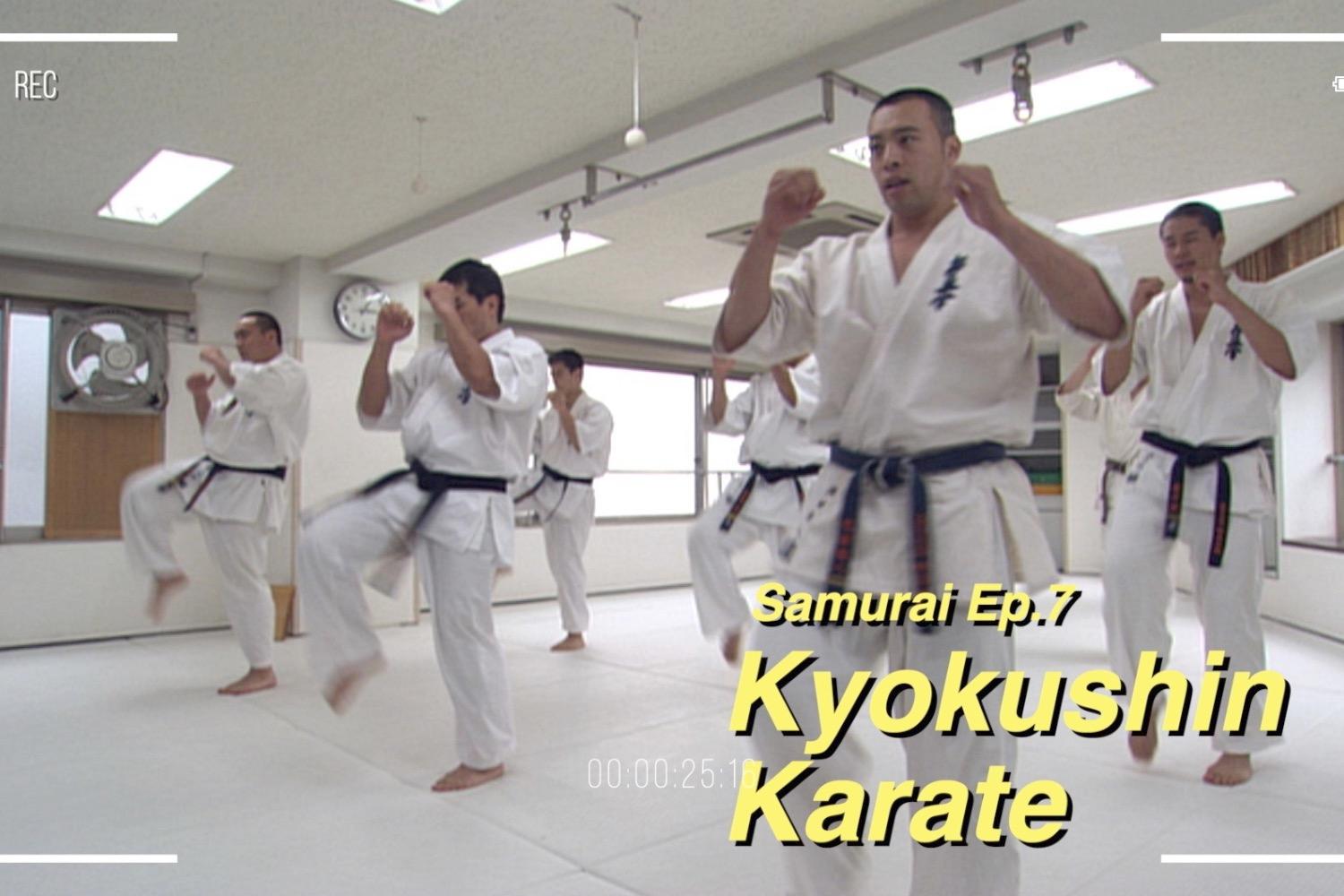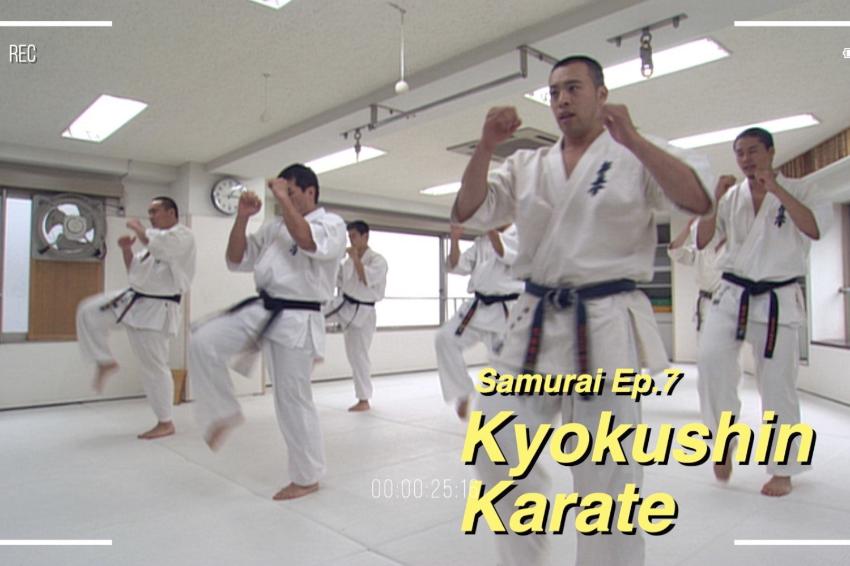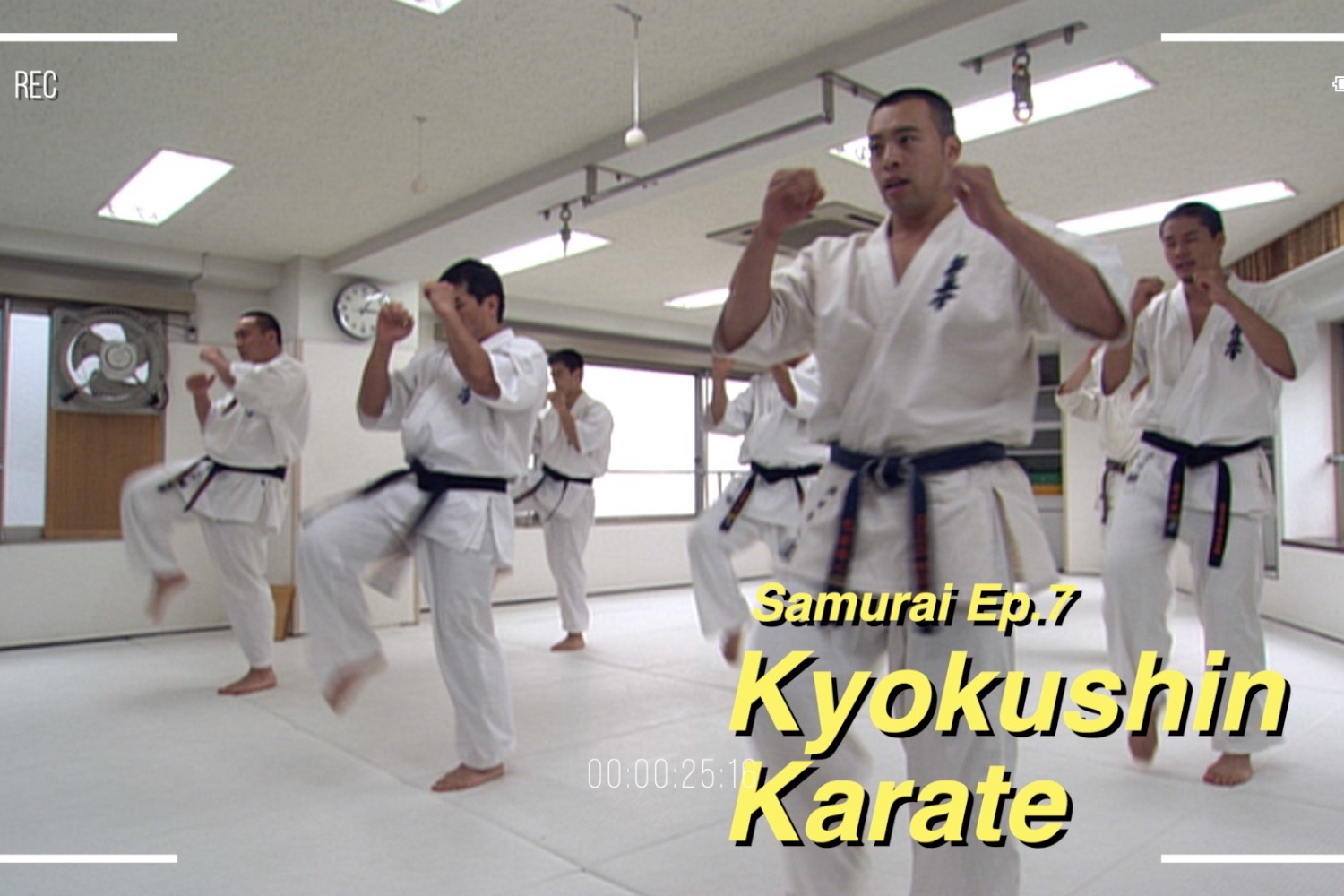2003년 다큐멘터리
생활 속의 무술
무사(武士)
7화 [일본 무술의 스포츠화2 - 가라데]
- 최영의(극진 가라테 창시자) 자료 (空手道)
1951년 폐허의 일본을 한 사내가 경악시킨다.
최배달로 알려진 최영의.
그는 50여마리의 황소와 맨손격투를 벌여 36마리의 쇠뿔을 잘라버렸다.
소 세마리가 그자리에서 즉사했다.
- 최영의 사진
그는 전후 일본의 자존심을 회복시켰다.
- 쇼케이 마쓰이, 극진 가라데 2대 관장 인터뷰
(무도가라는 것도 그렇지만 호걸이라는 느낌이 드는 분이었습니다.
아주 뭐랄까 정열적인 분으로 매우 뭐랄까 격렬한 면 또 인정이 많은 면이 있었습니다.
요컨대 정열적인 분이었다고 생각합니다.)
- 극진 가라테 자료
최영의는 1952년 일본 유도 대표와 함께 미국 순회 시범 공연을 가졌다.
그후 미국 FBI 사범을 맡으면서 미국 내 가라테 보급에 큰 역할을 했다.
- 극진 가라데 시범
최영의는 1961년 미국에서 자신만의 무술, 극진가라테를 창립한다.
극진가라테에서는 자유롭고 거친 겨루기를 강조한다.
무엇보다도 실전성을 중시하는 것이다.
- 쇼케이 마쓰이, 극진 가라데 2대 관장 인터뷰
(그게 뭐냐면 이른바 실천없이는 증명되지 않고 증명 없이는 신용을 얻지 못하고 신용이 없으면 존경받지 못한다.
또 정의 없는 힘은 무능한 것이고 힘없는 정의도 무능하다.)
- 극진 가라데 시범
이런 극진의 정신은 최영의의 실전에서 나온 것이다.
그는 세계를 돌며 100여차례의 격투기를 가져 단한번도 지지 않았다고 한다.
- 극진 가라데 이름표
그의 실전 정신을 전파하는 극진회관이 전세계 140여개국에 5천개가 넘는다.
- 최영의(극진 가라데 창시자) 사진
극진 가라테 인구는 천만 정도로 추산된다.
무술의 본질을 몸으로 직접 보여준 그는 지금도 신화로 남아있다.
- 쇼토칸 가라데 자료
사실 일본 본토의 가라데 역사는 그리 길지 않다.
가라데는 오키나와테로 불리던 오키나와의 전통 무술로, 기술이 복잡하고 배우기 어려웠다.
후나고시 기친은 그 기술을 단순화, 체계화 시켰고, 그후 가라테는 유도, 검도와 함께 일본의 대중 무술이 됐다. 후나고시 키친(船越義珍)
하지만 1950년대까지 가라데 시합은 실제로 치고 받는 형태로 이뤄졌다.
- 하스겐 카이히토, 일본가라데연맹 부회장 인터뷰
(그래서 이래서는 시합이 안 되겠다 해서 1957년 들어서 처음으로 대학이 룰을 만들어서
맞히지 않는 가라데 그건 거의 검도 같은 것이었죠. 양구석에 심판이 서서
뻗으면 이게 한판이다, 코앞까지 오면 한판이고 실제로 맞히면 반칙이라는 겁니다. 원칙적으로는 그랬고
주먹을 약간 피했다거나 혹은 약했다거나 하면 효과, 그래서 효과가 두개면 한판이라고 했습니다.)
- 쇼토칸 가라데 도장 쇼토칸(松涛館) 가라테
가라데는 또한 일본 경제의 발전과 함께 전세계에 보급됐다.
가라테는 비약적으로 성장하는 일본 국력의 상징이었다.
후나고시 기친이 가라테를 보급한 쇼토칸의 한 지부.
이곳에는 지금도 그 명성을 듣고 찾아오는 수련생들이 많다.
- 카도우 아에루, 쇼토칸 가라데 수련생 인터뷰
(그 전에 고우주류라는 곳에서는 접근전이 주였는데 그걸 죽도법으로 배웠고
그 뒤 쇼토칸에서 멀리 있는 상대를 쓰러뜨린다고 해서
가까이 있는 상대와 멀리 있는 상대를 다 쓰러뜨릴 수 있는 걸 배우고 싶기 때문에 앞으로 계속 할 생각입니다)
- 쇼토칸 가라데 수련생들
하지만 과거와 달리 수련생의 90%가 어린 학생들이다.
무술 수련의 마음가짐도 크게 달라졌다.
- 사와키타 히로, 쇼토칸 가라데 사범 인터뷰
(가령 도장에 목례하는 걸 잊어버리기만 해도 따귀가 올라왔고 신발을 가지런히 할 때도 무릎을 꿇고 두손으로 정리해야했고
걸레질도 정성스럽게 해야하는 등 굉장히 엄격했습니다.
만약 30년 전 당시의 연습방법을 지금의 아이들에게 시키면 폭력 도장으로 불릴 겁니다.)
- 쇼토칸 가라데 시범
수련생의 숫자도 점점 줄고 있다.
현재 이 도장의 수련생은 50여명 정도.
일본 전국적으로도 가라데 인구는 점점 줄고 있는 실정이다.
- 사와키타 히로, 쇼토칸 가라데 사범 인터뷰
(상당히 어렵습니다. 이렇게 건물을 빌린 경우 한달 집세라든지 모두 빌려서 하기 때문에
들어온 수련비의 대부분이 집세로 없어집니다.)
- 쇼토칸 가라데 사범 도복
일본 경제가 호황을 누리고, 가라테가 전성기를 누리던 시절.
그 화려한 시절은 이미 지나가버린 것일까?
(에필로그)
- 일본 도심, 젊은이들 모습
국가와 민족이 우선시 되던 과거와 달리 현재 일본은 서구식 개인주의가
지배하고 있다.
나를 죽이고 희생하는, 그래서 나를 이기는 것이 진정한 승리라고 여겼던 일본의 무사도(武士道).
그 정신은 이제, <47인의 무사(武士)>처럼 고전으로만 전해지고 있는지도 모른다.
2003 Documentary, Martial Arts in Life
Japanese warrior: Samurai, Episode 7
[Power without justice is incompetent - Kyokushin Karate]
00:00:02 - Choi Young-eui (Mas Oyama), founder of Kyokushin Karate
00:00:04
00:00:05 A man astonishes the ruins of Japan in 1951.
00:00:11 Choi Young-eui (Mas Oyama), known as Choi Bae-dal.
00:00:15 In a bare-handed fight with 50 bulls, he cut off the horns of 36 bulls.
00:00:22 Three cows died on the spot.
00:00:29
00:00:31 He restored Japan's self-esteem after the war.
00:00:37
00:00:37 - Interview with Shokei Matsui, the 2nd Director of [Kyokushin Karate
00:00:39 (He was a person who felt like an exciting person, even though he was a martial artist.
00:00:45 He was a very passionate person, and he had a very, very intense side and a very compassionate side.
00:00:57 In short, I think he was a passionate person.)
00:01:09
00:01:11 - Choi Young-eui demonstration scene
00:01:12 In 1952, Choi Young-ui toured the United States with a Japanese judo representative.
00:01:18 After that, he served as an FBI instructor in the United States and played a major role in distributing karate in the United States.
00:01:25
00:01:31 - Demonstration of Kyokushin Karate
00:01:36 Choi Young-ui founded his own martial art, Kyokushin Karate, in the United States in 1961.
00:01:47 In Kyokushin Karate, free and rough competition is emphasized.
00:01:51 Above all, it emphasizes practicality.
00:01:58 - Interview with Shokei Matsui, the 2nd Director of Kyokushin Karate
00:02:00 What it means is that without practice you are not proven, without proof you cannot be trusted, and without credit, you are not respected.
00:02:12 Also, power without justice is incompetent, and justice without power is incompetent.)
00:02:26
00:02:27 This spirit of Kyokushin comes from Choi Youngui's actual battle.
00:02:33 He is said to have fought over 100 fights around the world and never lost.
00:02:39 - Kyokushin Karate Demonstration
00:02:42 There are over 5,000 Kyokushin Halls in 140 countries around the world that spread the spirit of his practice.
00:02:49
00:02:53 - Picture of Choi Young-eui(founder of Kyokushin Karate)
00:02:54 The population of Kyokushin Karate is estimated to be around 10 million.
00:02:59 He showed the essence of martial arts through his body and remains a myth even today.
00:03:03
00:03:08 In fact, the history of karate in mainland Japan is not very long.
00:03:12 Karate is a traditional Okinawan martial art called Okinawa-te, and the technique is complex and difficult to learn.
00:03:19 Funagoshi Kichin simplified and systematized the technique, and after that, karate became a popular Japanese martial art along with judo and kendo.
00:03:30 However, until the 1950s, karate competitions were actually sparring.
00:03:37
00:03:39
00:03:45
00:03:48 - Interview with Kaihito Hasugen, Vice President of the Japan Karate Federation
00:03:48 (So, it was the first time in 1957 that a match could not be played,
00:03:52 so the university made a rule and did not match it. It was almost like kendo.
00:04:06 If it's a match, it's a match if it's close to your nose, and if you actually hit it, it's a foul.
00:04:15 In principle, it was like that, and if you slightly avoided your fists or if you were weak, it's an effect, so if there are two effects, it's a match.)
00:04:18
00:04:20 - Shotokan Karate Dojo
00:04:22 Karate has also spread around the world with the development of the Japanese economy.
00:04:28 Karate was a symbol of Japan's rapidly growing national power.
00:04:32
00:04:36
00:04:39 A branch of Shotokan where Funagoshi Kichin spread karate.
00:04:44 Even now, some trainees come here to hear the fame.
00:04:51
00:04:53 -Aeru Kado, interview with Shotokan karate trainee
00:04:56 (Before that, close combat was the main focus in Goujuryu,
00:05:02 After that, in the Shotokan, it was said that he defeated an opponent far away
00:05:09 I want to learn how to defeat everything, so I plan to continue doing it in the future)
00:05:14
00:05:17 -Shotokan Karate Demonstration
00:05:17 However, unlike in the past, 90% of the trainees are young students.
00:05:23 The mindset of martial arts training has also changed significantly.
00:05:27
00:05:31 - Interview with Sawakita Hiro and Shotokan Karate Instructor
00:05:33 (For example, even if I forgot to visit the dojo,
00:05:37 I got stings, and when I was getting my shoes organized,
00:05:43 I had to get down on my knees and clean them with both hands.
00:06:05 If the practice methods of 30 years ago were taught to the children of today, they would be called a violent dojo.)
00:06:18
00:06:24 The number of trainees is also decreasing.
00:06:27 Currently, there are about 50 trainees at this dojo.
00:06:33 The karate population in Japan is also on the decline.
00:06:41 - Interview with Sawakita Hiro and Shotokan Karate Instructor
00:06:44 (It is quite difficult. If you rent a building like this, you will have to rent it for a month or so,
00:06:54 so most of the training expenses you received will be lost as rent.)
00:06:58
00:07:01
Japanese warrior: Samurai, [epilogue]
2003 Documentary, Martial Arts in Life
00:07:05 A time when the Japanese economy was booming and karate was in its heyday.
00:07:09 Have those splendid days gone by?
00:07:17
00:07:18
00:07:23 Unlike in the past, when the nation and nation were prioritized,
00:07:27 Japan is currently dominated by Western-style individualism.
00:07:33 The Japanese samurai martial arts that killed and sacrificed themselves,
00:07:35 and that defeating me was the true victory.
00:07:50 That spirit may now be passed down only through classics like.
00:08:01







